#botallack
Explore tagged Tumblr posts
Text
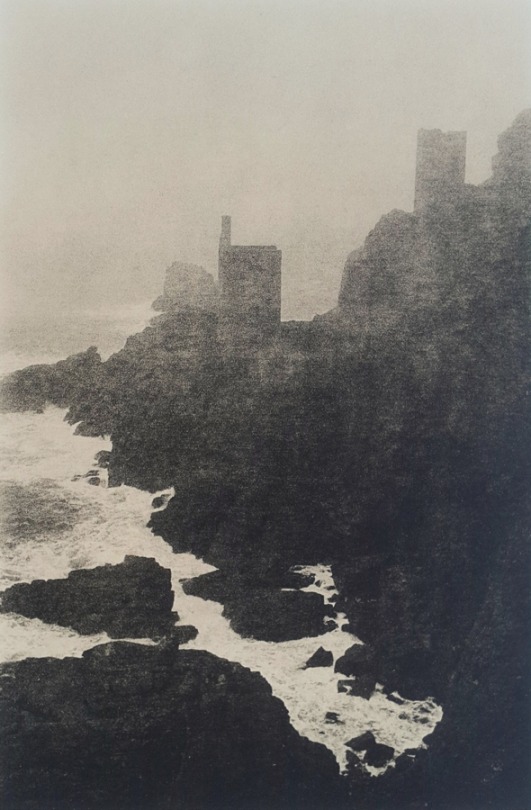
Clive Vincent, The Crown Mines, Botallack (2019)
from here
105 notes
·
View notes
Text
Cornwall 2024 - Tag 17
Ladies and Gentlemen!
Heute sind wir am westlichen Punkt Englands angekommen: Land’s End. Da es sich um eines der Top-Reiseziele in Cornwall handelt, ist frühes erscheinen erforderlich.

Dieser ganze Rummelplatz mit Vergnügungsmeile und Bespaßung ist uns deutlich zu viel. Wir waren jedoch gut vorbereitet und fuhren direkt auf den links daneben liegenden Hotelparkplatz. Von dort kann man genauso gut sehen, ohne diesen ganzen Klimbim.

Dabei ist in der Vorsaison noch nicht einmal richtig viel los. Wie groß muss der Trubel erst in der Hochsaison hier sein?

Uns beschleicht der Verdacht: jeder Brite muss hier einmal gewesen sein. Die Schönheit der Natur, der Ausblick, das Meer, die Wanderrouten, all das interessiert nur die Wenigsten.

Die Besucher hier sind laut, jeder nur mit sich, seiner Familie und natürlich mit dem Smartphon beschäftigt.

Nix wie weg! Haken dran, Beweisfotos machen und schnell weiter fahren.

Nur rund sechs Kilometer von dem trubeligen Land’s End entfernt liegt das sehr viel stillere Cape Cornwall, landschaftlich nicht weniger schön.

Eine kleine Straße, gesäumt von den typischen Mauern und Hecken, führt auf den Parkplatz des National Trusts. Dort befindet sich ein kleines Besucherzentrum in dem man sich über diesen Zipfel Cornwalls informieren kann.

Wir haben Glück, die See ist heute ruhig an dieser rauen Küstenlinie. Doch davon darf man sich nicht täuschen lassen.

Auf der Seeseite des Hügel sehen wir eine Station der Coast Watch. Hier, am Cape Cornwall, gibt es, wie überall an der Küste, Freiwillige die Dienst zur Überwachung und Sicherung der Küste machen.

Im 19. Jahrhundert operierte hier eine Zinnmine, die schon von weitem, durch ihren 1864 erbauten Schornstein, zu sehen ist. Dieser Schlot erinnert an die harte Arbeit vergangener Generationen, die ihre Spuren in den Felsen hinterlassen haben.

Ein kleines Turmgebäude, es sieht ein wenig wie ein Leuchtturm ohne Leuchten aus und ist auch das Letzte, was von der Cape Cornwall Mine übrig geblieben ist und wird heute im Volksmund "The Heinz Monument" genannt.

Im Jahr 1987 kaufte nämlich die, weltweit durch ihren Tomaten-Ketchup bekannte Firma, Heinz Company das Gelände an der Atlantikküste auf und schenkte es dem National Trust. Dieser nahm dieses Geschenk natürlich mit Kusshand an.

Heute ist es Teil der Cornish Mining World Heritage Site. Die US-Firma, die Niederlassungen auch in Großbritannien hat, wollte mit dieser großzügigen Geste an die ersten hundert Jahre erinnern, in denen Produkte der Heinz Company im Königreich verkauft wurden.

Bauunternehmer hatten schon ein Auge auf diese großartige Landschaft geworfen, da kam dieser Eingriff von Seiten der Firma Heinz gerade recht. Eine Steintafel, die eine Inschrift trägt, am Monument erinnert an die Schenkung.

Vom Parkplatz aus schlagen wir den Weg über eine Wiese zum St. Helen's Oratory ein.

Die Überreste dieser Kapelle und des Gebetsoratoriums liegen an einem grasbewachsenen Hang mit Blick auf das zerklüftete Meer und die Küste rund um.

Das Oratory umfasste ursprünglich eine mittelalterliche Kapelle mit zugehörigem Wohngebäude und Gehegen für die Nutztiere. Die Kapelle ist als kleines, dachloses Gebäude mit einer Länge von 6,1 m und einer Breite von 4,2 m erhalten geblieben, das bis zur Traufhöhe reicht.

Südlich und westlich der Kapelle befindet sich eine ebene Plattform, die vermutlich ein zugehöriges Wohnhaus darstellt, das größtenteils als vergrabene Elemente und Ablagerungen erhalten ist.

Um das Wohnhaus herum und an die Kapelle angeschlossen ist eine Einfriedung, die durch eine Stein- und Erdbank begrenzt wird, die bis zu 17 m lang und 9 m breit ist und an die Kapellenwände anschließt.

An einem ruhigem Tag ist es hier herrlich, muss aber unvorstellbar hart gewesen sein, als die Atlantikstürme hereinbrachen, da der Ort allen Südwestwinden ausgesetzt ist. Es ist wirklich ein Standort am „Ende der Welt“.

Wanderer sitzen auf den Bänken, die überall an den Wegrändern stehen, und genießen den Ausblick. Der Blick in die Ferne findet keinen Halt. Ja genau, das nächste Festland ist dann tatsächlich Amerika.

Abseits des Trubels und der Massen bewahrt sich Cape Cornwall eine gewisse Authentizität. Wir sind froh, das Land’s End all die Touristen anzieht und wir nur wenige Kilometer weiter so einen netten Platz finden.

Noch einen Fun Fact am Rande. Vor der Küste von Cape Cornwall liegt im Meer eine Felsenformation, The Brisons, die in der Region noch einen anderen Namen hat, nämlich „De Gaulle in der Badewanne“.

Und tatsächlich, wenn man genau hinschaut, sieht man den Kopf des früheren französischen Staatspräsidenten mit seiner charakteristischen Nase und seinem Bauch aus dem Meer herausragen.

Vom Cape Cornwall aus startet auch der Tin Coast Wanderweg. Die sieben Meilen lange Route verläuft entlang der alten Zinnminen vom Cape Cornwall bis zum Leuchtturm von Pendeen und den Tälern im Süden. Damit sind alle Fans der TV-Serie Poldark bestens vertraut.
Die Serie spielt in der Zeit des Zinnrauschs. Zahllose Schmelzen und Zinndörfer entstanden und Cornwalls Minen, in denen mehr als 50.000 Menschen arbeiteten, deckten 2/3 des Weltbedarfs.

Hier haben die Menschen das Gestein seit Hunderten von Jahren abgebaut und auf der Suche nach Zinn und Kupfer ihre Stollen tief unter die Erde und manchmal unter das Meer getrieben.

Diese reiche und zerklüftete Küste ist von der Bergbaugeschichte Cornwalls geprägt. Die Tin Coast, die seit 2006 zum Weltkulturerbe gehört, verfügt an ihrem zerklüfteten Rand über beeindruckende verlassene Bauwerke und verfallene Maschinenhäuser.

Hier gibt es jede Menge Geschichte. Daher ist es an einem so abgelegenen Ort mit Blick auf den Atlantischen Ozean leicht möglich, sich vorzustellen, wie das Leben vor mehreren hundert Jahren hier aussah.
Heute rahmen zerstörte Maschinenhäuser und Schornsteine die Landschaft ein und schaffen eine ganz besondere Atmosphäre.

Unsere nächste Station ist Botallack. Der National Trust besitzt und unterhält auch die Zinnminen Botallack und Levant. Wir machen auf jeden Fall das Beste aus unserer Mitgliedschaft.
Für unseren Besuch in der Zinnminen Botallack nutzten wir den Parkplatz The Botallack Count House. Dies liegt direkt neben dem Zinnbergbaugebiet Botallack und ist mit der Mitgliedschaft kostenlos.

Als sich am Nachmittag der Himmel immer mehr zuzieht und Nebel aufkommt, fahren wir zurück ins Cottage.
Good Night!
Angie, Micha und Mister Bunnybear
8 notes
·
View notes
Text

Botallack copper/tin mine Cornwall,
more info here; https://en.wikipedia.org/wiki/Botallack_Mine
9 notes
·
View notes
Text
Reenactment is so fun. I’m going next week.
#I can’t believe I was so nervous I nearly didn’t go#everyone was so lovely and nice#big wedding going on which was some added comedy#next week it’s a 5+ hour drive to upton! big event!#I’ve not got my firearms lisence so I can’t partake in the battle#but I’m very happy#going from a small campsite of 9 to one with hundreds of people is gonna be#uh.#I’ll burn that bridge when I get there#for now! I’m so excited and I’m so SO happy I went!#I’ve got my job as fight choreographer I might borrow a sword#it was such a blast#my body is ruined#talked about the Franklin Expedition with a guy in his 50s for a while that was so much fun#’DID YOU KNOW —‘ ‘OHMYGOD DID YOU HEAR—‘ ‘I WANT TO REALLY SEE THE SHIPS!’ ‘SAME!!’#talked about Cornish mining history <3#got very excited to tell people about the underwater mines at Levant/Geevor/Botallack#and all abt Hannah Snell#I MET SOME ARCHEOLOGISTS!#AH!
13 notes
·
View notes
Text



West Wheal Owles Mine, Engine House, Botallack, St. Just, Cornwall, 1967-1970. West Wheal Owles engine house viewed from the east at twilight with Wheal Edward in the background. Wheal Owles was used as the setting for the Poldark family mines of Wheal Leisure in the BBC television series (2015 onwards). Artist Eileen Deste.
9 notes
·
View notes
Text
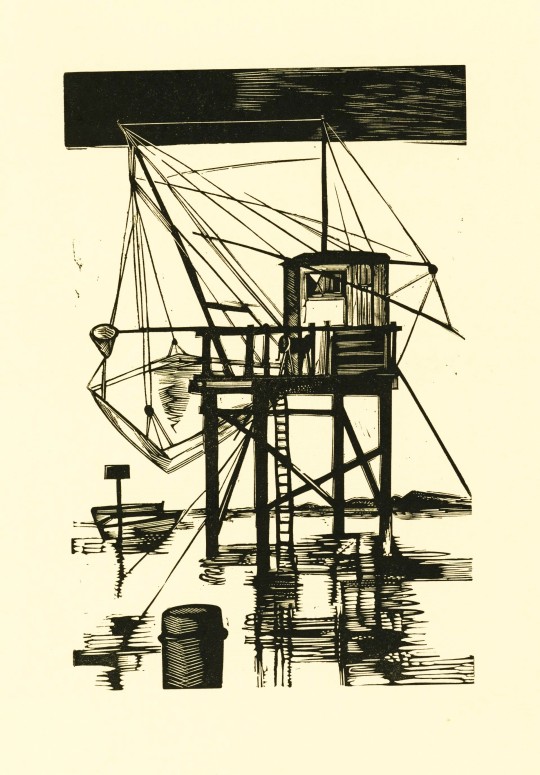


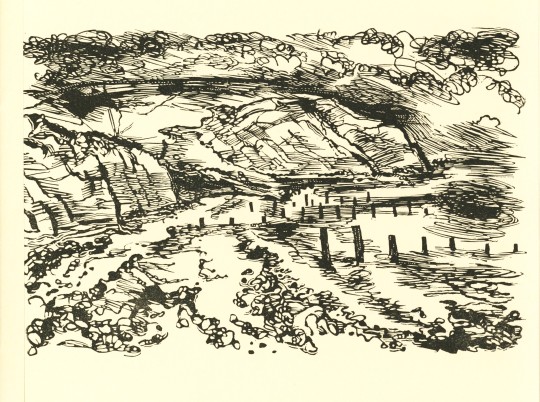
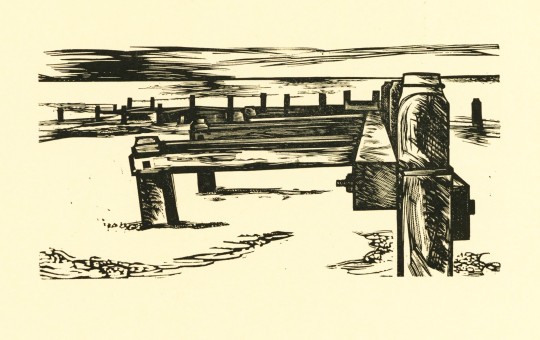
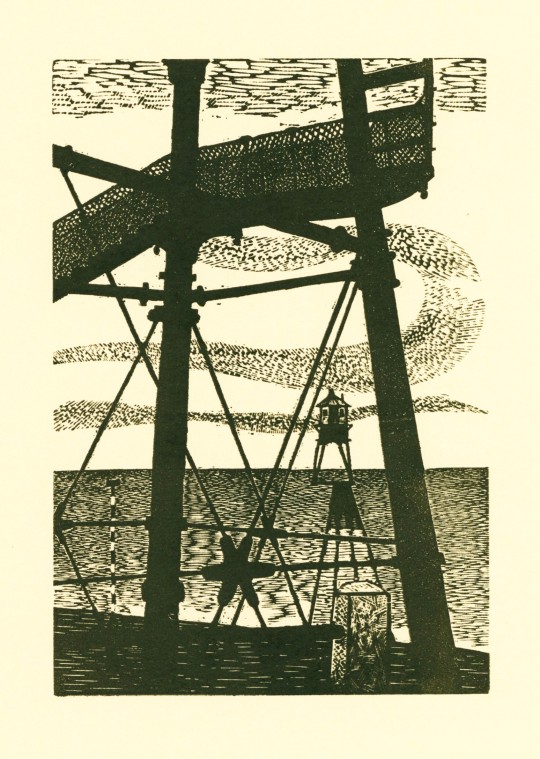

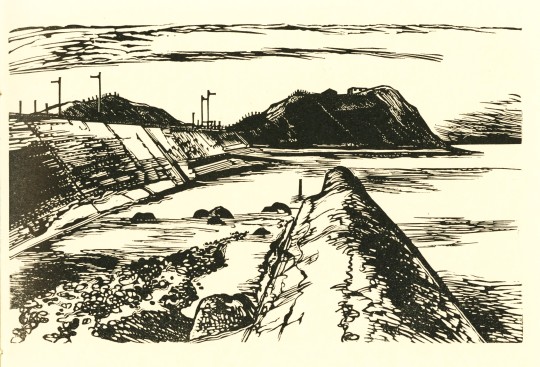
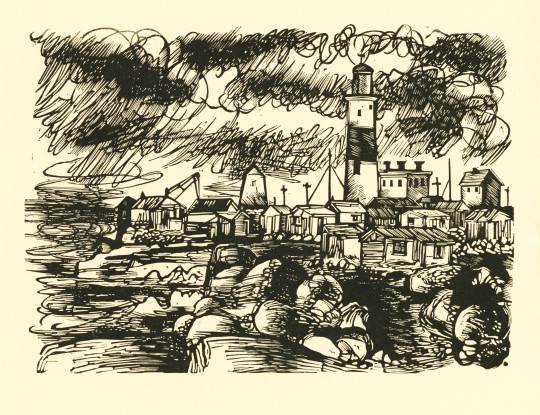
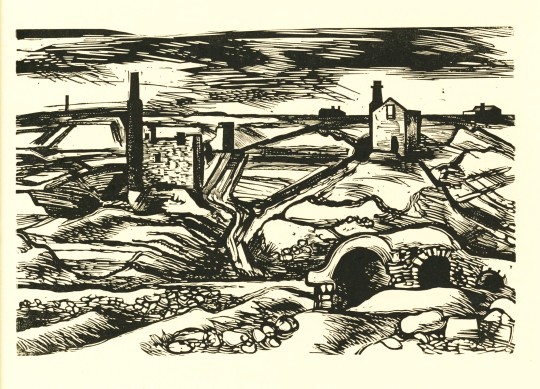

Wood Engraving Wednesday
KENNETH LINDLEY
English artist and wood engraver Kenneth Lindley (1928-1986) designed, engraved, and printed Coastwise in a limited edition of 50 copies at his own Pointing Finger Press in Yorkshire in 1970. Our copy is signed by Lindley. He studied wood engraving with James Bostock and Norman Janes, and became an art educator himself starting in 1950, eventually becoming Head of Wakefield School of Art in 1966 and then Principal of the Herefordshire College of Art in 1971.
Lindley was inducted as a member of the Society of Wood Engravers in 1960 just before this venerable institution began to fall into dissolution. It was through Lindley's efforts, however, along with those of engravers Hilary Paynter and George Tute, that the Society was revived in 1984, "virtually amounting to a re-foundation after a difficult mid-century." Today the Society is thriving and active.
The places depicted in these wood engravings are, from top to bottom: Brittany, St. Mary's Island, St. Osyth's Beach, Ballard Point, Holland Haven, Dovercourt, Stackpole Quay, Braystones, Portland, Botallack, and Maryport.
View more posts with wood engravings!
#Wood Engraving Wednesday#wood eingravings#wood engravers#Kenneth Lindley#Pointing Finger Press#Coastwise#Society of Wood Engravers#fine press books#fine press printing.
29 notes
·
View notes
Text

Botallack, England - by Mark Dobson
@ombre-ame upload
4 notes
·
View notes
Text
Botallack, Angleterre - par Mark Dobson

Botallack, England - by Mark Dobson
887 notes
·
View notes
Text
Selected Poems by W.S. Graham

The Thermal Stair
For the painter Peter Lanyon killed in a gliding accident 1964
I called today, Peter, and you were away. I look out over Botallack and over Ding Dong and Levant and over the jasper sea.
Find me a thermal to speak and soar to you from Over Lanyon Quoit and the circling stones standing High on the moor over Gurnard's Head where some
Time three foxglove summers ago, you came. The days are shortening over Little Parc Owles. The poet or painter steers his life to maim
Himself somehow for the job. His job is Love Imagined into words or paint to make An object that will stand and will not move.
Peter, I called and you were away, speaking Only through what you made and at your best. Look, there above Botallack, the buzzard riding
The salt updraught slides off the broken air And out of sight to quarter a new place. The Celtic sea, the Methodist sea is there.
You said once in the Engine House below Morvah That words make their world In the same way as the painter's Mark surprises him Into seeing new. Sit here on the sparstone In this ruin where Once the early beam Engine pounded and broke The air with industry. Now the chuck of daws And the listening sea.
'Shall we go down' you said 'Before the light goes And stand under the old Tinworkings around Morvah and St Just?' You said 'Here is the sea Made by alfred wallis Or any poet or painter's Eye it encountered. Or is it better made By all those vesselled men Sometime it maintained? We all make it again.'
Give me your hand, Peter, To steady me on the word.
Seventy-two by sixty, Italy hangs on the wall. A woman stands with a drink In some polite place And looks at S A R A C I N E S C O And turns to mention space. That one if she could Would ride Artistically The thermals you once rode.
Peter, the phallic boys Begin to wink their lights. Godrevy and the Wolf Are calling Opening Time. We'll take the quickest way The tin singers made. Climb here where the hand Will not grasp on air. And that dark-suited man Has set the dominoes out On the Queen's table. Peter, we'll sit and drink And go in the sea's roar To Labrador with wallis Or rise on Lanyon's stair.
Uneasy, lovable man, give me your painting Hand to steady me taking the word-road home. Lanyon, why is it you're earlier away? Remember me wherever you listen from. Lanyon, dingdong dingdong from carn to carn. It seems tonight all Closing bells are tolling Across the Duchy shire wherever I turn.
***
I Leave This at Your Ear
For Nessie Dunsmuir
I leave this at your ear for when you wake, A creature in its abstract cage asleep. Your dreams blindfold you by the light they make.
The owl called from the naked-woman tree As I came down by the Kyle farm to hear Your house silent by the speaking sea.
I have come late but I have come before Later with slaked steps from stone to stone To hope to find you listening for the door.
I stand in the ticking room. My dear, I take A moth kiss from your breath. The shore gulls cry. I leave this at your ear for when you wake.
***
Approaches To How They Behave
What does it matter if the words I choose, in the order I choose them in, Go out into a silence I know Nothing about, there to be let In and entertained and charmed Out of their master's orders? And yet I would like to see where they go And how without me they behave.
2
Speaking is difficult and one tries To be exact and yet not to Exact the prime intention to death. On the other hand the appearance of things Must not be made to mean another Thing. It is a kind of triumph To see them and to put them down As what they are. The inadequacy Of the living, animal language drives Us all to metaphor and an attempt To organize the spaces we think We have made occur between the words.
3
The bad word and the bad word and The word which glamours me with some Quick face it pulls to make me let It leave me to go across In roughly your direction, hates To go out maybe so completely On another silence not its own.
4
Before I know it they are out Afloat in the head which freezes them. Then I suppose I take the best Away and leave the others arranged Like floating bergs to sink a convoy.
5
One word says to its mate O I do not think we go together Are we doing any good here Why do we find ourselves put down? The mate pleased to be spoken to Looks up from the line below And says well that doubtful god Who has us here is far from sure How we on our own tickle the chin Of the prince or the dame that lets us in.
6
The dark companion is a star Very present like a dark poem Far and unreadable just out At the edge of this poem floating. It is not more or less a dark Companion poem to the poem.
7
Language is expensive if We want to strut, busked out Showing our best on silence. Good Morning. That is a bonny doing Of verbs you wear with the celandine Catching the same sun as mine. You wear your dress like a prince but A country's prince beyond my ken. Through the chinks in your lyric coat My ear catches a royal glimpse Of fuzzed flesh, unworded body. Was there something you wanted to say? I myself dress up in what I can Afford on the broadway. Underneath My overcoat of the time's slang I am fashionable enough wearing The grave-clothes of my generous masters.
8
And what are you supposed to say I asked a new word but it kept mum. I had secretly admired always What I thought it was here for. But I was wrong when I looked it up Between the painted boards. It said Something it was never very likely I could fit in to a poem in my life.
9
The good word said I am not pressed For time. I have all the foxglove day And all my user's days to give You my attention. Shines the red Fox in the digitalis grove. Choose me choose me. Guess which Word I am here calling myself The best. If you can't fit me in To lying down here among the fox Glove towers of the moment, say I am yours the more you use me. Tomorrow Same place same time give me a ring.
10
Backwards the poem's just as good. We human angels as we read Read back as we gobble the words up. Allowing the poem to represent A recognizable landscape Sprouting green up or letting green With all its weight of love hang To gravity's sweet affection, Arse-versa it is the same object, Even although the last word seems To have sung first, or the breakfast lark Sings up from the bottom of the sea.
11
The poem is not a string of knots Tied for a meaning of another time And country, unreadable, found By chance. The poem is not a henge Or Easter Island emerged Longnose Or a tally used by early unknown Peoples. The words we breathe and puff Are our utensils down the dream Into the manhole. Replace the cover.
12
The words are mine. The thoughts are all Yours as they occur behind The bat of your vast unseen eyes. These words are as you see them put Down on the dead-still page. They have No ability above their station. Their station on silence is exact. What you do with them is nobody's business.
13
Running across the language lightly This morning in the hangingover Whistling light from the window, I Was tripped and caught into the whole Formal scheme which Art is. I had only meant to enjoy Dallying between the imaginary And imaginary's opposite With a thought or two up my sleeve.
14
Is the word? Yes Yes. But I hear A sound without words from another Person I can't see at my elbow. A sigh to be proud of. You? Me?
15
Having to construct the silence first To speak out on I realize The silence even itself floats At my ear-side with a character I have not met before. Hello Hello I shout but that silence Floats steady, will not be marked By an off-hand shout. For some reason It refuses to be broken now By what I thought was worth saying. If I wait a while, if I look out At the heavy greedy rooks on the wall It will disperse. Now I construct A new silence I hope to break.
***
The Night City
Unmet at Euston in a dream Of London under Turner's steam Misting the iron gantries, I Found myself running away From Scotland into the golden city.
I ran down Gray's Inn Road and ran Till I was under a black bridge. This was me at nineteen Late at night arriving between The buildings of the City of London.
And then I (O I have fallen down) Fell in my dream beside the Bank Of England's wall to bed, me With my money belt of Northern ice. I found Eliot and he said yes
And sprang into a Holmes cab. Boswell passed me in the fog Going to visit Whistler who Was with John Donne who had just seen Paul Potts shouting on Soho Green.
Midnight. I hear the moon Light chiming on St Paul's.
The City is empty. Night Watchmen are drinking their tea.
The Fire had burnt out. The Plague's pits had closed And gone into literature.
Between the big buildings I sat like a flea crouched In the stopped works of a watch.
***
Loch Thom
Just for the sake of recovering I walked backward from fifty-six Quick years of age wanting to see, And managed not to trip or stumble To find Loch Thom and turned round To see the stretch of my childhood Before me. Here is the loch. The same Long-beaked cry curls across The heather-edges of the water held Between the hills a boyhood's walk Up from Greenock. It is the morning.
And I am here with my mammy's Bramble jam scones in my pocket. The Firth is miles and I have come Back to find Loch Thom maybe In this light does not recognise me.
This is a lonely freshwater loch. No farms on the edge. Only Heather grouse-moor stretching Down to Greenock and One Hope Street or stretching away across Into the blue moors of Ayrshire.
2
And almost I am back again Wading the heather down to the edge To sit. The minnows go by in shoals Like iron-filings in the shallows. My mother is dead. My father is dead And all the trout I used to know Leaping from their sad rings are dead.
3
I drop my crumbs into the shallow Weed for the minnows and pinheads. You see that I will have to rise And turn round and get back where My running age will slow for a moment To let me on. It is a colder Stretch of water than I remember.
The curlew's cry travelling still Kills me fairly. In front of me The grouse flurry and settle. GOBACK GOBACK GOBACK FAREWELL LOCH THOM.
***
To Alexander Graham
Lying asleep walking Last night I met my father Who seemed pleased to see me. He wanted to speak. I saw His mouth saying something But the dream had no sound.
We were surrounded by Laid-up paddle steamers In The Old Quay in Greenock. I smelt the tar and the ropes.
It seemed that I was standing Beside the big iron cannon The tugs used to tie up to When I was a boy. I turned To see Dad standing just Across the causeway under That one lamp they keep on.
He recognised me immediately. I could see that. He was The handsome, same age With his good brows as when He would take me on Sundays Saying we'll go for a walk.
Dad, what am I doing here? What is it I am doing now? Are you proud of me? Going away, I knew You wanted to tell me something.
You stopped and almost turned back To say something. My father, I try to be the best In you you give me always.
Lying asleep turning Round in the quay-lit dark It was my father standing As real as life. I smelt The quay's tar and the ropes.
I think he wanted to speak. But the dream had no sound. I think I must have loved him.
***
To My Wife at Midnight
Are you to say goodnight And turn away under The blanket of your delight?
Are you to let me go Alone to sleep beside you Into the drifting snow?
Where we each reach, Sleeping alone together, Nobody can touch.
Is the cat's window open? Shall I turn into your back? And what is to happen?
What is to happen to us And what is to happen to each Of us asleep in our places?
2
I mean us both going Into sleep at our ages To sleep and get our fairing.
They have all gone home. Night beasts are coming out. The black wood of Madron
Is just waking up. I hear the rain outside To help me to go to sleep.
Nessie, dont let my soul Skip and miss a beat And cause me to fall.
3
Are you asleep I say Into the back of your neck For you not to hear me.
Are you asleep? I hear Your heart under the pillow Saying my dear my dear
My dear for all it's worth. Where is the dun's moor Which began your breath?
4
Ness, to tell you the truth I am drifting away Down to fish for the saithe.
Is the cat's window open? The weather is on my shoulder And I am drifting down
Into O can you hear me Among your Dunsmuir Clan? Are you coming out to play?
5
Did I behave badly On the field at Culloden? I lie sore-wounded now
By all activities, and The terrible acts of my time Are only a distant sound.
With responsibility I am drifting off Breathing regularly
Into my younger days To play the games of Greenock Beside the sugar-house quays.
6
Nessie Dunsmuir, I say Wheesht wheesht to myself To help me now to go
Under into somewhere In the redcoat rain. Buckle me for the war.
Are you to say goodnight And kiss me and fasten My drowsy armour tight?
My dear camp-follower, Hap the blanket round me And tuck in a flower.
Maybe from my sleep In the stoure at Culloden I'll see you here asleep
In your lonely place.
***
The Fifth of May
This morning shaving my brain to face the world I thought of Love and Life and Death and wee Meg Macintosh who sat in front of me In school in Greenock blushing at her desk. I find under the left nostril difficult, Those partisans of stiff hairs holding out In their tender glen beneath the rampart of The nose and my father's long upperlip.
***
Myself the Day Desires
Myself the day desires I thought So I woke early up and scrubbed My parts and spirit and went out As hero to see what I could find.
I walked across and I walked between Black Madron's trees with my stick Swishing the nettles of the queen And I gave the young brambles an extra lick.
And over my desiring head The morning sky was trailed by others. So I was out by these words led Between the hedges and the feathers.
If while I tell you this you want To interrupt with your some question Think twice. The dear I am infant Has started out and he is gone
Is gone on the blue rainlit road Away and away from what the words call Anything that I never could Have as my home at all.
1 note
·
View note
Text

Clive Vincent, Botallack 2 (2019)
from here
27 notes
·
View notes
Text

Studio of British artist Rose Hilton in her home in Botallack, West Cornwall.
0 notes
Text

Botallack Mines ,Cornwall, UK. ( Maine, USA approx. 2800 miles to the left).
Copper ,tin and arsenic were mined herehttps://en.wikipedia.org/wiki/Botallack_Mine. More info here;
19 notes
·
View notes
Text

Lower engine house at Botallack near St Just - Cornwall by Andrew Ray
1 note
·
View note
Text
Okay SO

For whatever reason, I ASSUME Poldark is supposed to take place on the eastern coast? Because in S2E1, we see Demelza take a coach going from Falmouth to Bodmin. Which are not near each other at all and since it’s an important route I’d assume they’d stop through Truro as it was an extremely important town since, ya know, the capital. And we know then it’s going north and she could just walk with her luggage to the main road without assistance. So POSSIBLY the estate itself is somewhere in between Truro and Bodmin? But those are both landlocked.
SO LETS TALK ABOUT THE MINE ALREADY
Botallack Mine was the place where they filmed a lot of the mining scenes. It’s at St. Just — here’s a picture of it for reference

It is rocky and it’s rugged and the Atlantic is just pummelling the coastline but it also looks nothing like the coastline around Mevagissey (and yes I realise neither place looks like it did in the 1780s) however there is absolutely a difference (for example, not AS rocky and certainly has more Beach — also the flora is different, there’s certainly more sea grass in the St. Austell-Mevagissey area). Also, for the town scenes they did film in Charlestown which isn’t on this map but is right outside of St. Austell. So MAYBE that’s where it’s all intended to take place.
ALSO. Demelza is said to come from Illugan which is just outside Redruth. So, it doesn’t have much to do with anything except holy shit, she walked a long damn way just to go to market. Let’s just say she’s Like That I guess (even though tbh Illugan would make more sense geographically). Also there was loads of inland mining as well but I’m not counting central Cornwall in this because the red string in the cork board in my brain is getting confusing and I could probably rig a ship with it.
So, I guess the imaginary Poldark Mine and the home are somewhere between Fowey and St. Mawes at the longest measure?? And maybe call it a 30-45 minute ride by horse to get to the coast?? And said coast just happens to be a really steep area? I dunno, man. But it probably takes place in some area roughly there. Maybe. Considering places like Bodmin and Falmouth are fairly easy to get to and back in a single day. I haven’t read the books. But it does feel like the location scout found the best places where they could easily film without interruption or public interference and just shrugged and said it was vaguely Cornwall.
All of this to say when I see places like St. Agnes and Polzeath in a show taking place on the other side of the peninsula, it fucks with my sense of location and takes me out of the show for a bit. Confuses my mind. Where am I. Who am I. I lost my sense of identity in the Red String Theory of Where Precisely The Fuck Does This Fictional Show Take Place
The geography of Poldark confounds and confused me
#it’s just WEIRD#but I think I’ve just got to let go of my sense of realism and just let it wash over me#tbh I don’t think it would be as south as St Mawes but like#but it just. it’s just wrong.#you can’t go showing shots of Botallack and be like yep that’s moved it’s over HERE now#anyways#extremely inconsequential#I just had to rid this from my system#jesus wept#this show can drive me insane for historical reasons sometimes#but on the whole I enjoy it#I CANT WAIT FOR THE FRENCH REVOLUTION I CANNOT WAIT#I NEED TO SEE THE MINERS STRIKES AND (near) UPRISING NOW#I NEED TO SEE IT ACCURATELY DEPICTED OR I WILL EXPLODE#i realise most people come to this show for hot people and pretty scenery#but oh no. I can’t. I tried. incapable.#saying this prolific mining community is actually taking place in PRIMARILY fishing villages and towns is turning my brain inside out
12 notes
·
View notes
Text

Crowns Engine Houses, Botallack Mine
Cornwall, England
...
1 note
·
View note
Photo

Rare British Hübnerite & Wolframite Crystal - Botallack, Cornwall - Ex-Collection - 100% Genuine w/ COA
Rare British Hübnerite and Wolframite Crystal from Botallack, Cornwall - Ex-Collection
This rare Hübnerite and Wolframite crystal was sourced from the historic mining region of Botallack, Cornwall. Part of an ex-collection, this specimen beautifully combines the reddish-brown hues of Hübnerite with the metallic luster of Wolframite, two minerals that are highly prized among collectors. This unique piece offers a glimpse into Cornwall's rich mining history and is a must-have for any serious collector of British minerals.
Key Features:
Origin: Botallack, Cornwall, England, UK
Crystal Types: Hübnerite and Wolframite
Ex-Collection: Rare and collectible British mineral specimen
Certificate of Authenticity: All of our crystals are 100% genuine specimens and come with a Certificate of Authenticity.
Exact Specimen: The crystal shown in the photo is the exact piece you will receive, carefully chosen for its unique features and aesthetic appeal.
Scale: A 1 cm cube is included in the photo for accurate size reference. Please see the photos for full dimensions.
This rare Hübnerite and Wolframite crystal is perfect for collectors, geologists, or those fascinated by the minerals of Cornwall’s famous mining districts. It makes a striking display piece and a great addition to any mineral collection, showcasing both beauty and historical significance.
Buy with confidence – all items are securely packaged to ensure safe delivery. Feel free to contact us with any questions before purchasing. Thank you for browsing!
0 notes